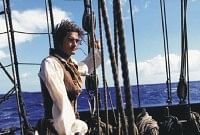
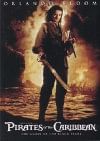
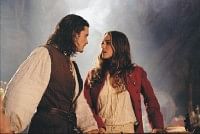
Orlando Boom
About
Orlando
Born
on January 13th 1977 in Canterbury, England, Orlando Bloom's plans
of becoming an actor developed quite early when he realized that the
characters on TV and in the movies weren't real, that they were actors.
"Once I realized that I could be Superman or I could be The Hustler
or I could be Daniel Day Lewis's character in The Last Of The Mohicans
- I was like, "Man, I can become an actor and be all of those
things." In 1993, he moved to London to improve his career, doing
bit parts in TV series like "Casualty". Orlando spent two
years at the National Youth Theatre before getting a scholarship to
train with the British American Drama Academy. His first memorable
appearance, a cameo in the critically acclaimed movie Wilde in 1997,
earned him various film offers, which he all turned down in favor
to play theatre. After Wilde, Orlando attended the Guildhall School
of Music and Drama for 3 years. On stage, he appeared in plays like
"The Seagull", "Twelfth Night", and "Trojan
Women". Peter Jackson then "discovered" the classically
handsome Bloom for his much hyped Lord Of The Rings trilogy in 1999.
After doing the three Rings movies with Jackson, he worked with Ridley
Scott on Black Hawk Down. Since then, he has been working on new projects
non-stop. In 2003, four of his movies will be released: The Kelly
Gang, Pirates of the Caribbean, The Calcium Kid, and The Return of
the King. When he's not working, Orlando divides his time between
London and Los Angeles.
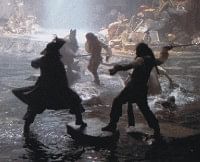
Orlando
Fact File
-His
birthdate is January 13, 1977, making him 26 years old.
-His nicknames are Orli and OB.
-He has brown hair and brown eyes.
-He's around 5'10" (180 cm)
-He's not married.
-He used to smoke, but quit in 2002, which caused him to start biting
his nails instead.
-While filming Lord of the Rings in New Zealand, he got into sky diving,
bungee jumping, paragliding, surfing and snowboarding. Now he enjoys
"just taking time to walk whether it be on location somewhere
or on a beach." "most of the time I just chill with my friends
and have a mellow time" He also enjoys photography, shopping
and buying old antiques, and he "can't stand computers".
-He says he's accident prone, and has the injury list to prove it.
He's broken his back, his ribs, his nose, both his legs, his arm,
his wrist, a finger and a toe, and cracked his skull three times!
-A year before doing the Lord of the Rings, he fell 3 stories off
a friend's porch while trying to open a jammed door and broke his
back. He was almost confined to a wheelchair, but luckily the doctors
were able to patch him up.

-His sister Samantha is 2 years older than him.
-His father, Harry Bloom, died when Orlando was 4 and was a legendary
figure in antiapartheid circles in South Africa. Harry also wrote
a famous tome called Episode In The Transvaal, was jailed for his
beliefs, and worked alongside Nelson Mandela. Orlando and his sister
were raised by their mother, Sonia, and a guardian, Colin Stone. When
Orlando was 13, his mother told him that Harry was not his biological
father, that Colin was.
-Has a tattoo of 'nine' in Elvis on his right forearm, and a sun on
his torso that he got when he was 15.
-He can speak French.
-He has 3 A levels, two at grade A (one was art and sculpture - he
is particularly good at sculture and pottery and art), one at A level
for Photography, and one at Grade C which was Religious Studies. He
also has 8 'O' levels and has a BA (Hons) Drama degree from Guildhall
School of Music and Drama - so he is Orlando Bloom BA (Hons).
-As a kid, he was dyslexic, and now he says he is "mildly dyslexic".
-He says he's currently into "all sorts of music, mostly the
Ben Harper, the David Gray, and the Bob Dylan type of folk music."
-For LOTR, he had to learn archery, how to ride a horse bareback (while
shooting an arrow), and how to fight and wield two swords. "I
started off with archery, I rode about 20 different horses, I had
physical training in the gym, and I had to learn the Elvish ways of
speaking and fighting. Their fighting is based on ancient European
and Asian martial arts, so I had a trainer who taught me how to use
the blades. I also did a lot of movement training, because movement
is my way into the character." - SFX Magazine
-He originally auditioned for Lord of the Rings in the part of Faramir,
Boromir's brother, who wouldn't be introduced until The Two Towers.
He was turned down for that part, but was then asked to audition for
Legolas. He learned that he got the part the day before he graduated
from Guildhall.
-He wears a replica of the One ring that says "To wherever it
may lead." It was given to him by one of the make-up artists
on LOTR.
Album
Review
Prothom
Chittkar
By
Mushfique Mannan
After
releasing Metal Maze's debut album, G- Series did not come up with
any kind of album or mixed album. Everyone heard rumours that the
long- awaited mixed album "Prothom Chittkar" would come
out under G- Series. Finally, the album came out under the new record
company Tone & Tune. Though the recording and mixing was not satisfactory,
this was all Tone & Tune could do to promote the featured underground
bands in this album.
The album starts
off with a slow rock song "Cholo Jaai" by Dark Fate. A typical
rock song, with the usual riffs and solos. But I'm sure the band could've
come up with a different name for the band, as their band's name suggests
that they've taken the idea from the great Cryptic Fate.
The
next two songs are not worth mentioning. But I'll have to write about
them for the sake of this review in anyway. Track 2 is entitled "Feeray
Chai" by a band called Desh. And Track 3 is entitled "Priyotoma"
by a band named Elixir. Both the songs have the same theme in their
lyrics, love, as suggested by their titles.

Though the next
song is also a slow, alternative song, this song will definitely be
a welcome break after listening to the first three tracks. "Shei
Din" by Fulbanu's Revenge is a really nice song and also has
great lyrics. Both their vocalist and guitarist has shown true talent
and their versatile capability as young musicians.
The next slow,
rock song in line is "Drishtir Shimana" by Blaze. Just one
of the typical songs, with the same rhythm, same solos and keyboard
tunes. Songs like these might appeal to the slow rock listeners.
The only solo
singer in this album is Ciphar. His song "Eka" is a complete
rocker! After all those stereotype slow songs, this song breaks off
the silence with a good Metal performance. The vocal is not that good
but the solo towards the end of the song is really superb.
The next song
is probably one of the best songs in this album. "Obhishaap"
by Kraal is a very popular song in the Underground Metal scene. Good
recording of the song could've have proved everything for the band.
Half the solos in the song are barely audible. This song is kind of
kind of nostalgic because it will take the listeners back to the Master
Of Puppets era. Rafa, their vocalist- cum- drummer really has true
talent for Heavy Metal. He also plays drums for the Thrash band Psykokinesis.
Side B of the
album starts off with a great song. "Nei Ki Proyojon" by
Pyroclastic is the best slow song in this album. Anyone who will listen
to this will say it is a superb song. Vocalist Bappa and guitarist
Aushi played really well in this song. This song is likely to attract
all types of listeners.
"Kannar Rong"
by Biborna is the next song in line. A typical Hard Rock song. Listening
to this song will be a change after listening to all those slow songs
in Side A. Nothing so remarkable about the song, though.
Thrash Metal fans
can finally listen to Psykokinesis's "Opobaad". It's a pretty
catchy song, though it has common riff styles. This song highly resembles
"Territory" of Sepultura, esp. the drum lines. The vocalist
will surely surprise you because he is a short guy and has a voice
like that of Chris Barnes of Six Feet Under.
To say the truth,
"Protiddhoni" by Fumes is the lousiest track in the whole
album. They wanted to be a sideshow of Aurthohin, like composing typical
slow songs. Firstly, they didn't even come close in achieving that.
And lastly, they were even lousier when they used synthesized drums
in their song.
Schoolmates Birodh
has showed people that they are capable of doing Heavy Metal with
their track "Durdom Nesha". Though the vocalist tried to
mimic Jon of Black in many cases (and later turned out to be pretty
bad), guitarist Tanveer and drummer Moin really showed their talent
for Heavy Metal. Birodh has been doing great lately and is slowly
coming to the limelight.
"Durey"
by Breach is a pretty nice alternative song. Though not one of the
best songs, it has a nice rhythm throughout the whole song.
The last song
in the album is by a band called Punoruthhan. Their song "Cactus
Bhul" is a pretty catchy song. Hard Rock and ArtCell fans won't
be disappointed! In fact, the whole idea of the song resembles the
song "Onno Shomoy" by ArtCell.
To
sum up everything, there are more slow songs than Metal songs in this
album. Still more or less an average album. But the recording could've
been better. The reason why Tone & Tune didn't bring out CDs is
because the company didn't find any sponsors to finance the album.
The record deal was very raw for all the bands and they had to do
it for the sake of popularity. Now that the bands had exposures about
recording, they'll be able to cut out better deals in the future.
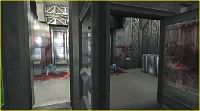
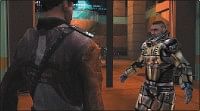
Chaser
Some
games are too clever by half. Today's technology allows game designers
so much leeway for creativity that they sometimes get caught up in
adding bells and whistles to a game without ever creating a core of
fun gameplay first. With the near-future shooter Chaser, Slovakian
developer Cauldron has made a game that might not be the flashiest
out there, but is one with a whole lot of heart. It doesn't break
much new ground, and it's not as polished as it should be, but it
offers loads of thrilling, old-school shooter action.
Chaser
opens with cinematic verve aboard a massive space station orbiting
Earth sometime in the near future. As the opening credits roll, two
small ships roar toward the station. As soon as they dock, armed troops
in body armor and menacing masks pour into the station. Meanwhile,
in a medical lab elsewhere aboard the station, the amnesiac hero of
the game, John Chaser, suffers through frightening flashbacks as he
lies on an examining table. The flood of disturbing images awakens
Chaser, who's serving as some sort of test subject in an experiment
we can only guess at. Just as Chaser groggily gets to his feet, the
troops come barreling around the corner toward the lab. When they
spot Chaser, they open fire, missing our hero but setting off a chain
reaction that threatens the entire station.
And
with that, the chase is on as you try to escape the station with your
life. With a nod to Half-Life (and countless sci-fi movies), conduits
burst around you, electric arcs from broken relay panels dance across
the floor, and huge support beams coming crashing down around your
head. As if that weren't enough, there seems to be an enemy soldier
at every turn. Fortunately, you grab one of their guns early on, and
for the rest of the opening level, you blast your way to freedom in
one fast-paced firefight after another.
From
there, it's back to Earth, where you get mixed up with the Mafia and
the Yakuza, engage in countless fierce firefights in varied locales,
do a little infiltration and espionage work, and ultimately head to
Mars to uncover the secret behind Chaser's past. The story leads you
into political intrigue at the highest levels, with an evil political
and business cartel trying to eradicate rebel freedom fighters on
Mars.
None
of this is particularly original, but developer Cauldron knows how
to milk a proven cliché for all it's worth. For instance, the
opening sequence aboard the space station sounds--and ultimately is--hackneyed,
but it's handled quite nicely. The intro cinematic is crafted with
directorial flair, using some exciting camera angles and editing to
create a fun action sequence that also shows just how confused the
hero is.
The
gameplay that immediately follows the intro movie is filled with nonstop
action. Some shooters try to get fancy with all kinds of clever cutscenes,
scripted events, and role-playing elements, and sometimes those work
spectacularly. But ultimately, shooters are action games, and without
exciting action, you don't have much to build on. Fortunately, you
get into one blazing firefight after another during Chaser's first
mission--and indeed in almost every mission. Guards pop out of doorways
and ambush you from behind crates, and cross fire erupts at intersections.
A warehouse shootout during a later mission is so over the top, so
outrageously violent, that it would make John Woo proud. In another
highlight of the game, you engage in a long, running gun battle in
a luxury hotel. Glass shatters as grenades and bullets fly every which
way, steam pipes vent with a hiss when they get hit, and blood splatters
the walls as the bodies pile up. It feels like a cross between a Quentin
Tarantino movie and the famous lobby battle in The Matrix. In fact,
Chaser includes an "adrenaline mode" that lets you slow
time like in that film or Max Payne. It's not necessary for success,
and combat is usually more exciting at full speed, but it's a nice
option to have for particularly tough encounters.
Chaser's
villains aren't brilliant, but they act smartly enough to provide
a real challenge. They'll frequently take cover, and they have aim
that's good enough to keep you on your toes--or rather, keep you ducking
behind pillars and crates. They're also placed very well throughout
the levels to ensure some fun surprises. Between the placement of
enemies and the frequency and pacing of the firefights, Chaser at
times bears a surprising resemblance to Doom, but with smarter enemies
and real-world weapons. That's no small praise.
